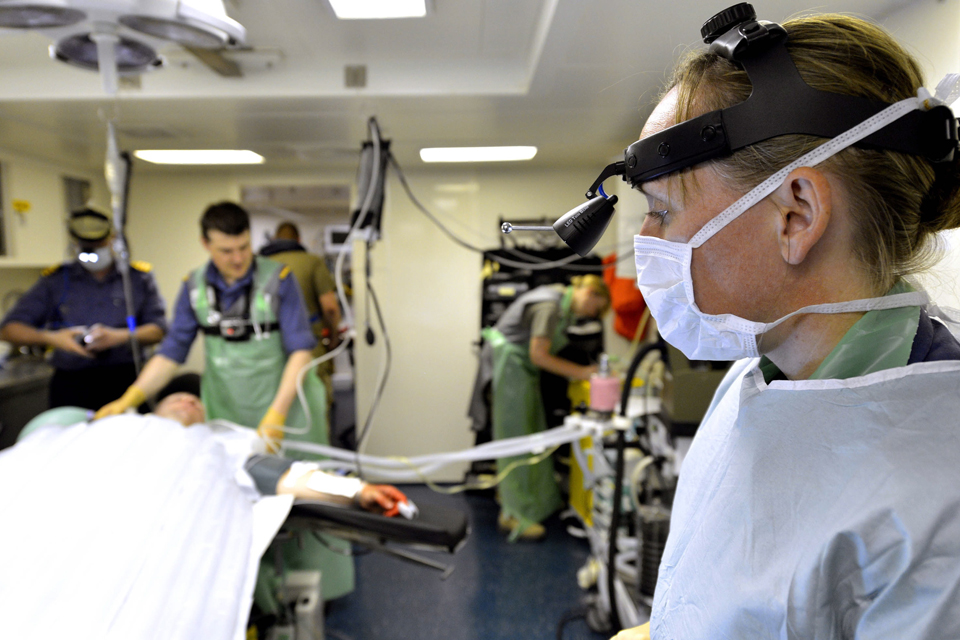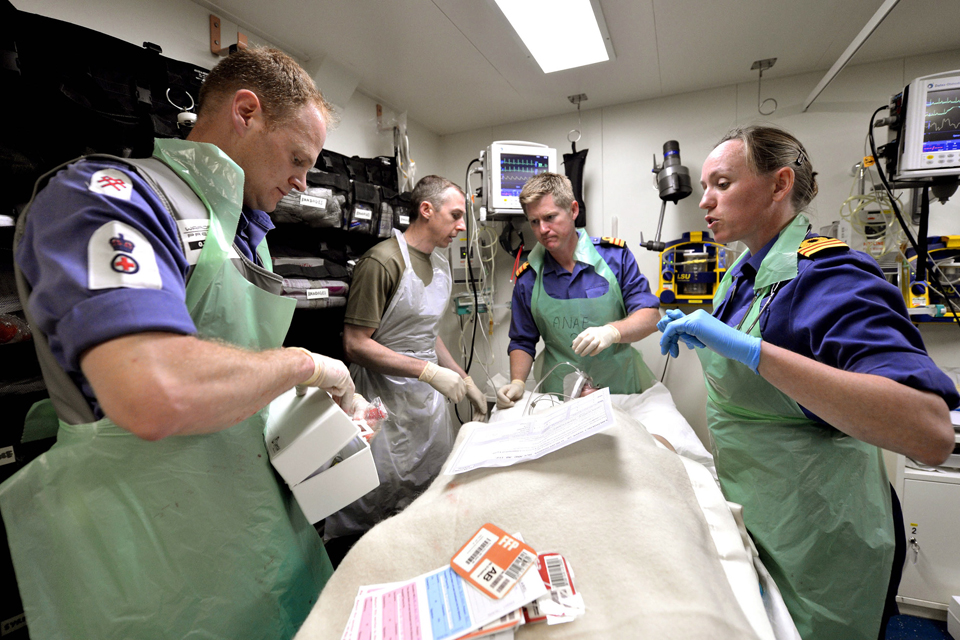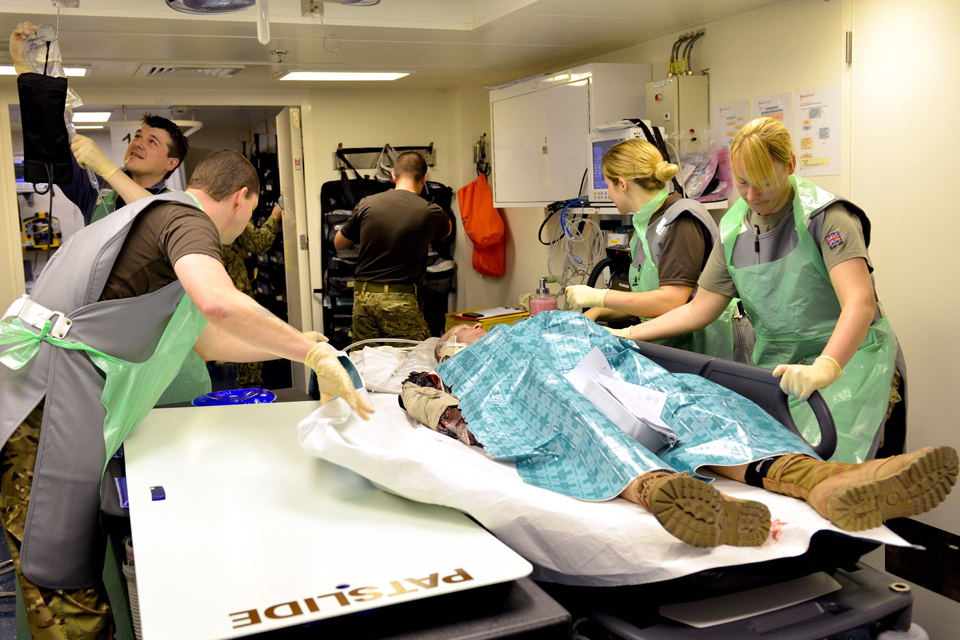Military medics in Gulf casualty exercise
The sick bay of RFA Cardigan Bay was the medical hub of a major multinational 2-day mass casualty exercise in the Gulf recently.
![Medics in action in RFA Cardigan Bay's sick bay [Picture: Petty Officer (Photographer) Paul A'Barrow, Crown copyright]](https://assets.publishing.service.gov.uk/media/5a618873e5274a0a1b10da88/s300_SC_MQ130005008.jpg)
Medics in action in RFA Cardigan Bay's sick bay
An explosion rips through the hull of a merchant vessel, critically wounding 6 members of the crew. Two are in danger of losing limbs, another can’t breathe, and a fourth has deep burns across his chest.
The casualties are flown to the nearby Royal Fleet Auxiliary (RFA) ship Cardigan Bay, where the specialist military medics, doctors and nurses of the Role 2 Afloat (R2A) Team are waiting.
For the team members, this is a high-pressure situation where life and limb are on the line. The scenario may be fictional, and the casualties may be actors, but the responses and reactions have to be perfect.

Surgeon Commander Catherine Doran gets ready to operate as Surgeon Commander Simon Mercer preps the patient [Picture: Petty Officer (Photographer) Paul A'Barrow, Crown copyright]
Best known for their role in the field hospitals of Afghanistan, the medical staff of the R2A Team are keen to show that they can work anywhere in the world.
To prove this, as part of International Mine Countermeasures Exercise 2013 (IMCMEX 13), they conducted a mass casualty exercise – a simulated incident with numerous serious injuries.
A specialist make-up artist and 2 professional actors from Amputees in Action were brought in to add even more realism to the scenario, and, to put the surgeons of the R2A Team to the ultimate test, there was an amputation at sea.
The aim of the mass casualty exercise was to prove that the R2A Team can operate from the medical facilities aboard RFA Cardigan Bay, and her sisters Lyme Bay and Mounts Bay.
Three of our platforms are Bay Class ships, but we’ve never deployed on one before,” explains Surgeon Commander Richard Heames, the Officer in Charge of the R2A Team.
As a result, our first main training aim is to validate ourselves in our ability to operate from this type of ship and deal with patients using the facilities on board.
We’re also here to provide support to the IMCMEX, offering real-world cover to everyone involved.
18 members of the R2A Team lived and worked aboard RFA Cardigan Bay during IMCMEX 13, which took place over 2 weeks in the Gulf region. It is the largest exercise of its kind in the world, bringing together personnel, ships and other military assets from over 40 countries.

Medics in action in RFA Cardigan Bay's sick bay [Picture: Petty Officer (Photographer) Paul A'Barrow, Crown copyright]
The mass casualty exercise took place over 2 days, allowing time for a realistic simulation of both the merchant vessel incident and a ‘mine strike’ aboard a minehunter – a scenario which involved multiple ships, helicopter and boat movements, and a great deal of co-ordination.
By involving the 2 casualties from Amputees in Action, the medics were able to practise with far more complicated ‘injuries’ than they can normally train on realistically.
John Pickup, director of Amputees in Action and one of the simulated casualties, said:
This is the first time we’ve trained with the Royal Navy, and it’s been a great experience all round.
We do lots of work with the Armed Forces and emergency services. The reality of our injuries enables us to play very real, but simulated, casualties and provide a realistic level of training that a lot of people wouldn’t normally be exposed to.
For Leading Hand (Administrative Assistant) Jacqueline Todd, one of RFA Cardigan Bay’s first aid team, the realistic exercise was an opportunity to put all her skills to the test. She said:
I’ve dealt with broken bones before, and that’s what I had on the first day of the exercise; however the amputee casualty was something new.
When he came off the helicopter, I didn’t stop to think about how gory and realistic the injury was. I just remembered my training, and knew I had to get a tourniquet on to stop him bleeding.
He came up to me afterwards and thanked me for my efforts, telling me that if I’d done what I did for real I would have saved his life. I asked him how he knew, and he said ‘because you tied it really tight!’

The medical team get ready to prep a casualty for an operation [Picture: Petty Officer (Photographer) Paul A'Barrow, Crown copyright]
The R2A Team also had to work seamlessly with RFA Cardigan Bay’s embarked medical team, the command structure for the exercise and in collaboration with a smaller medial facility aboard the United States Navy assault ship USS Ponce.
Leading Naval Nurse Lindsay Robinson is one of the R2A Team’s trauma nurses, and found herself in the thick of the action once the casualties started coming in. She said:
Everything came together during the exercise. We were able to deploy and set up out here within 48 hours, and during the scenario everything went really well.
The Amputees in Action and the make-up all add a huge sense of realism to the trauma cases we have to deal with.
Surgeon Commander Heames congratulated his team, as well as the staff from RFA Cardigan Bay and USS Ponce, saying:
The mass casualty exercise has been successful in developing the medical care process from point of injury, through lifesaving surgery aboard RFA Cardigan Bay, and onward transfer to hospital.
Once again, members of the Defence Medical Services have risen to the challenge of delivering an exceptionally high standard of medical care, this time in the unfamiliar maritime environment.